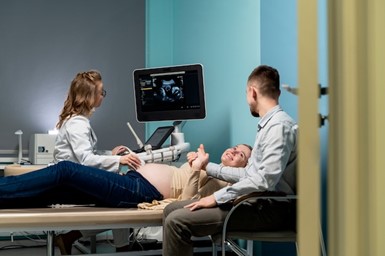It is also known as a viability ultrasound scan or viability assessment, is a medical procedure used to determine the viability of a pregnancy during its early stages. It is performed to confirm the presence of a gestational sac within the uterus and to assess whether the pregnancy is developing normally. It helps to determine if the pregnancy is viable, meaning that there is a fetal heartbeat, and the pregnancy has the potential to progress.
Here are detailed bullet points explaining what a viability scan entails:
- Typically performed between 6 to 10 weeks of gestation, although it can vary based on individual circumstances and doctor’s protocols.
- It is often recommended for women who have experienced symptoms such as vaginal bleeding, pain, or previous pregnancy complications.
Procedure
The scan usually starts with a transabdominal approach using gel on the abdomen and a transducer on the belly for ultrasound images. A transvaginal ultrasound may be used for better early pregnancy visualization when needed.
Key Assessments
- Gestational sac: The presence of a gestational sac is the first sign of pregnancy visualized during the scan.
- Fetal heartbeat: The viability scan aims to detect the fetal heartbeat, which typically becomes visible around six weeks of gestation.
- Size and growth: The gestational sac and embryo measurements are taken to assess growth and development.
- Location: Confirming that the gestational sac is located within the uterus and ruling out the possibility of an ectopic pregnancy (implantation outside the uterus).
Diagnostic Outcomes
- Normal findings: A visible gestational sac and fetal heartbeat indicate a viable pregnancy with a lower risk of miscarriage.
- Uncertain findings: If the findings are inconclusive or unclear, additional scans or tests may be recommended to monitor progression.
- Non-viable pregnancy: If no gestational sac is seen or if there is an absence of fetal heartbeat, it may indicate a non-viable pregnancy or miscarriage.
Patient Preparation
Patients advised to have a full bladder for transabdominal scans to improve visualization.
Counselling regarding the procedure’s purpose, potential findings, and emotional support may be provided before and after the scan.
In summary, a viability scan plays a crucial role in early pregnancy assessment by confirming the presence of a gestational sac, detecting fetal heartbeat, and evaluating overall pregnancy viability. It supports informed decision-making and ensures appropriate management of early pregnancy complications when necessary.


